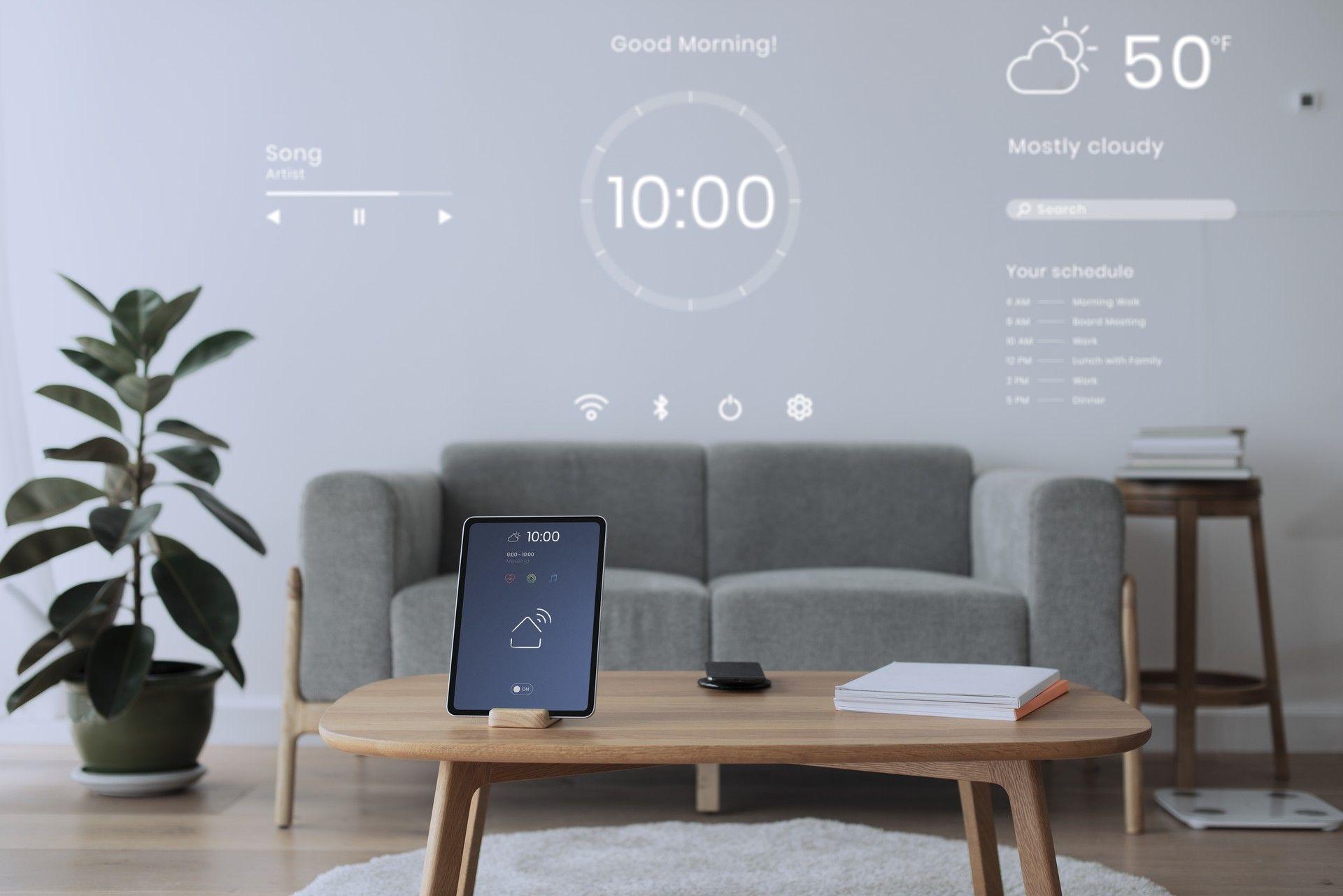In a world where technology’s evolution knows no bounds, a new paradigm has emerged, ambient computing, a vision of computing so intuitive and integrated that it transcends the boundaries of our awareness.
Imagine a world where technology gracefully fades into the background, where devices and systems blend seamlessly with the rhythm of our lives, enhancing every facet without demanding our conscious attention. This is not a scene from a science fiction movie; it’s the ambitious reality that ambient computing aspires to create.
As of 2023, sensors and artificial intelligence have already become a huge part of our lives. Doors that open on their own when we get closer to the one we saw in Star Trek, which shocked us all at the time, are now seen almost everywhere we go. As humanity has made huge technological advances in the last 30 years, especially in the last quarter of 2022, with AI-powered chatbots taking their place in our culture, the existence of an automated environment has started to seem like an inevitable reality rather than a shocking possibility.
This is exactly where ambient computing comes into play. So how far are we away from a system that evaluates our environment, emotions, and needs better than we do? Not that much…

What is ambient computing?
Ambient computing represents a groundbreaking approach that aims to seamlessly weave technology into the fabric of our surroundings, effortlessly integrating it into our daily lives. This approach prioritizes subtlety and unobtrusiveness, allowing technology to provide valuable support and information without demanding our conscious attention. It’s a marriage of cutting-edge technologies, including motion tracking, speech recognition, gestures, wearables, and artificial intelligence, all orchestrated to create an environment where computing becomes an integral, almost invisible, part of our existence.
Imagine walking into a room, and the lighting adjusts to your preferred settings, the temperature shifts to match your comfort level, and your favorite calming music starts playing softly in the background—all without you needing to touch a single device or issue a command. This is the promise of ambient computing—a technology where an algorithm knows you so well that it anticipates your needs before you’re even aware of them.
Evolution of ambient computing
Ambient computing is not just another step in the technological journey; it’s a significant leap forward in how humans interact with computers. While it builds upon the foundation of the Internet of Things (IoT), which brought us connected devices, ambient computing takes this concept further. IoT devices communicate over the internet, but ambient computing takes technology beyond connectivity. It aspires to be like the air we breathe, a constant and supportive presence in our lives, always ready to assist but never intrusive.
Consider the evolution of the smart home. In the past, a smart home might have meant remotely controlling lights or thermostats using a smartphone app. With ambient computing, the home learns your preferences over time and automatically adjusts settings to create an environment tailored to your needs. It’s a step beyond mere control; it’s the transformation of our environment into a dynamic and responsive partner.

How does ambient computing work?
At the heart of ambient computing is the convergence of artificial intelligence and sensors. Sensors act as the senses of the ambient environment, detecting inputs such as movement, voice commands, gestures, and even biometric data.
Once the sensors gather data, artificial intelligence takes the stage as the cognitive powerhouse of ambient computing. AI algorithms process the influx of real-time data, sifting through the noise to identify patterns, correlations, and insights that human minds might struggle to discern. Machine learning models, a subset of AI, play a pivotal role in this process by training on vast datasets and fine-tuning their understanding over time.
Sensors are the unsung heroes of modern-day technologies, serving as the digital senses that perceive and interpret the world around us. These sensors come in various forms, each tailored to capture specific inputs from our environment. Motion sensors detect movement within a room, while microphones capture our spoken commands and conversations. Cameras and depth sensors analyze gestures and body language, and biometric sensors gather physiological data such as heart rate, skin conductivity, and facial expressions.
Through complex neural networks and deep learning architectures, AI deciphers the sensory inputs, extracts contextual meaning, and generates contextually relevant responses. This process entails natural language processing (NLP) to understand spoken commands, computer vision to interpret gestures and facial expressions, and predictive modeling to anticipate future actions. The AI’s ability to make sense of diverse data types enables devices to interpret our actions, preferences, and even emotions, offering a level of personalization previously thought to be the stuff of science fiction.
Picture a scenario where you’re cooking dinner and your kitchen surfaces light up with helpful recipe suggestions, nutritional information, and step-by-step instructions projected onto your countertop. All this information is intelligently presented as you work, creating a hands-free and intuitive cooking experience. The technology fades into the background, allowing you to focus on the task at hand while it supports you in a discreet and powerful manner.

Ambient computing vs IoT
While ambient computing and the Internet of Things (IoT) might appear analogous on the surface, a closer examination reveals their distinct technical foundations and transformative potential.
IoT revolves around the interconnectivity of devices through the internet, enabling remote control and data monitoring. This connectivity is facilitated by sensors, actuators, and communication protocols that allow devices to communicate with centralized platforms or each other. Devices in an IoT ecosystem, often referred to as “smart devices,” gather data from their environment and share it over the internet. These devices are usually designed with specific functionalities in mind, such as remotely adjusting a thermostat or turning off lights using a smartphone app.
The crux of IoT lies in its ability to facilitate control and monitoring from a distance. For instance, in a smart home scenario, you can use your smartphone to turn off the lights or adjust the thermostat while you’re away. This centralized control is the cornerstone of IoT applications, enabling users to manage various devices without being physically present.
Ambient computing goes beyond IoT’s focus on remote control and monitoring. It aspires to create an environment where technology blends seamlessly into our physical spaces, augmenting our experiences in a contextually aware manner. This integration is achieved by employing a sophisticated combination of sensors, artificial intelligence, and responsive devices.
In an ambient computing setting, devices not only communicate but also collaboratively interact to create a holistic, context-aware experience. Sensors detect inputs like motion, sound, or biometric data, while AI processes this data to generate contextually relevant responses. The result is an environment that not only responds to user commands but anticipates needs based on real-time data analysis. Devices work together harmoniously, creating an immersive atmosphere where technology becomes an integral part of our surroundings.
Think of a smart office powered by IoT. Devices like smart lights and thermostats can be remotely controlled via a smartphone app. If a meeting room is unoccupied, you can turn off the lights from your phone to save energy. However, this control is reactive, dependent on user input.
In contrast, an ambient computing-enabled office goes a step further. The environment is equipped with an array of sensors that monitor factors such as occupancy, lighting conditions, and even employee stress levels. AI processes this data to autonomously adjust the lighting, and temperature, and even play soothing music if stress levels are high. This proactive adjustment creates an environment optimized for productivity and well-being without requiring explicit commands.

Watch out new business models
The advent of ambient computing is poised to reshape the landscape of business models across industries, ushering in a new era of possibilities and challenges.
This paradigm shift goes beyond technology; it fundamentally alters how companies interact with customers, create value, and innovate.
Personalization at scale
Ambient computing’s ability to gather rich, real-time data from sensor inputs and AI analysis lays the groundwork for unprecedented personalization. Businesses can leverage this data to deliver tailored experiences that cater to individual preferences, behaviors, and needs.
For instance, consider a retail scenario where a store adapts its layout, displays, and product recommendations based on a customer’s past purchases and browsing history. This level of personalization enhances customer engagement and loyalty, leading to increased sales and customer satisfaction.
Context-aware services
Ambient computing equips businesses with the tools to provide context-aware services that anticipate customer requirements. For example, a smart home security system can analyze patterns of activity to differentiate between normal household movements and potential security threats, minimizing false alarms.
In a healthcare context, wearable devices can monitor vital signs and send alerts to healthcare providers if anomalies are detected just like how AI changes healthcare. By offering services that seamlessly integrate with users’ lives and respond to specific contexts, businesses can deliver heightened value and efficiency.
Enhanced customer engagement
Ambient computing opens avenues for continuous and unobtrusive customer engagement. Imagine a restaurant that employs ambient technology to identify regular patrons as they enter, automatically recommending their favorite dishes and adjusting the lighting to their preferences.
This enhanced engagement creates memorable experiences and fosters stronger customer relationships. Businesses that harness ambient computing’s capabilities can build deeper connections with customers and stand out in a competitive marketplace.

Data-driven insights
The deluge of data generated by ambient computing can provide businesses with valuable insights into customer behavior, preferences, and trends. By analyzing this data, companies can refine their strategies, optimize their operations, and identify new market opportunities.
For instance, a grocery store equipped with sensors can analyze customer foot traffic and purchasing patterns to optimize product placement and inventory management. In this way, businesses can make informed decisions based on real-time, granular data.
Ethical considerations and trust
As businesses embrace ambient computing, they must address ethical concerns related to data privacy, security, and consent. Transparency in data collection and usage is paramount to maintaining customer trust.
Companies that prioritize privacy and adhere to ethical standards will be better positioned to build lasting relationships with customers and avoid potential reputational risks.
Redefining business strategies
The integration of ambient computing demands a fundamental reimagining of business strategies. Traditional models centered around standalone products or services may no longer suffice.
Businesses must shift toward creating holistic ecosystems that seamlessly integrate into customers’ lives. Companies that successfully navigate this shift will not only deliver superior value but also be at the forefront of innovation and industry leadership.
As ambient computing continues to evolve, it is set to redefine how businesses connect with customers, innovate, and differentiate themselves. The journey ahead requires a delicate balance between harnessing technology’s potential and addressing the ethical and practical challenges it presents. The businesses that embrace this evolution and actively shape their strategies to align with the ambient computing era will be well-positioned to thrive in this dynamic and transformative landscape.
Featured image credit: Freepik.






